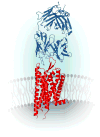Opportunities for functional selectivity in GPCR antibodies
- PMID: 22975405
- PMCID: PMC3729224
- DOI: 10.1016/j.bcp.2012.08.021
Opportunities for functional selectivity in GPCR antibodies
Abstract
Monoclonal antibodies (mAbs) have been used for decades as tools to probe the biology and pharmacology of receptors in cells and tissues. They are also increasingly being developed for clinical purposes against a broad range of targets, albeit to a lesser extent for G-protein-coupled receptors (GPCRs) relative to other therapeutic targets. Recent pharmacological, structural and biophysical data have provided a great deal of new insight into the molecular details, complexity and regulation of GPCR function. Whereas GPCRs used to be viewed as having either "on" or "off" conformational states, it is now recognized that their structures may be finely tuned by ligands and other interacting proteins, leading to the selective activation of specific signaling pathways. This information coupled with new technologies for the selection of mAbs targeting GPCRs will be increasingly deployed for the development of highly selective mAbs that recognize conformational determinants leading to novel therapeutics.
Copyright © 2012 Elsevier Inc. All rights reserved.
Figures


Similar articles
-
Emerging opportunities for allosteric modulation of G-protein coupled receptors.Biochem Pharmacol. 2013 Jan 15;85(2):153-62. doi: 10.1016/j.bcp.2012.09.001. Epub 2012 Sep 11. Biochem Pharmacol. 2013. PMID: 22975406 Review.
-
Engineering therapeutic antibodies targeting G-protein-coupled receptors.Exp Mol Med. 2016 Feb 5;48(2):e207. doi: 10.1038/emm.2015.105. Exp Mol Med. 2016. PMID: 26846450 Free PMC article. Review.
-
Discovery and design of G protein-coupled receptor targeting antibodies.Expert Opin Drug Discov. 2023 Apr;18(4):417-428. doi: 10.1080/17460441.2023.2193389. Epub 2023 Mar 29. Expert Opin Drug Discov. 2023. PMID: 36992620
-
Emerging structural insights into biased GPCR signaling.Trends Biochem Sci. 2014 Dec;39(12):594-602. doi: 10.1016/j.tibs.2014.10.001. Epub 2014 Nov 4. Trends Biochem Sci. 2014. PMID: 25458114 Review.
-
Reprogramming G protein coupled receptor structure and function.Curr Opin Struct Biol. 2018 Aug;51:187-194. doi: 10.1016/j.sbi.2018.07.008. Epub 2018 Jul 25. Curr Opin Struct Biol. 2018. PMID: 30055347 Free PMC article. Review.
Cited by
-
tANCHOR fast and cost-effective cell-based immunization approach with focus on the receptor-binding domain of SARS-CoV-2.Biol Methods Protoc. 2023 Dec 12;8(1):bpad030. doi: 10.1093/biomethods/bpad030. eCollection 2023. Biol Methods Protoc. 2023. PMID: 38090673 Free PMC article.
-
Engineered membrane protein antigens successfully induce antibodies against extracellular regions of claudin-5.Sci Rep. 2018 May 30;8(1):8383. doi: 10.1038/s41598-018-26560-9. Sci Rep. 2018. PMID: 29849184 Free PMC article.
-
Production of monoclonal antibodies against GPCR using cell-free synthesized GPCR antigen and biotinylated liposome-based interaction assay.Sci Rep. 2015 Jun 10;5:11333. doi: 10.1038/srep11333. Sci Rep. 2015. PMID: 26061673 Free PMC article.
-
Production of Immunizing Antigen Proteoliposome Using Cell-Free Protein Synthesis System.Methods Mol Biol. 2024;2766:63-81. doi: 10.1007/978-1-0716-3682-4_9. Methods Mol Biol. 2024. PMID: 38270868
-
Biased Gs versus Gq proteins and β-arrestin signaling in the NK1 receptor determined by interactions in the water hydrogen bond network.J Biol Chem. 2015 Oct 2;290(40):24495-508. doi: 10.1074/jbc.M115.641944. Epub 2015 Aug 12. J Biol Chem. 2015. PMID: 26269596 Free PMC article.
References
-
- Fredriksson R, Lagerstrom MC, Lundin LG, Schioth HB. The G-protein-coupled receptors in the human genome form five main families. Phylogenetic analysis, paralogon groups, and fingerprints. Mol Pharmacol. 2003;63:1256–1272. - PubMed
-
- Chen L, Jin L, Zhou N. An update of novel screening methods for GPCR in drug discovery. Expert Opin Drug Discov - PubMed
-
- Williams AF, Barclay AN. The immunoglobulin superfamily--domains for cell surface recognition. Annu Rev Immunol. 1988;6:381–405. - PubMed
-
- Kohler G, Milstein C. Continuous cultures of fused cells secreting antibody of predefined specificity. Nature. 1975;256:495–497. - PubMed
Publication types
MeSH terms
Substances
Grants and funding
LinkOut - more resources
Full Text Sources
Other Literature Sources

